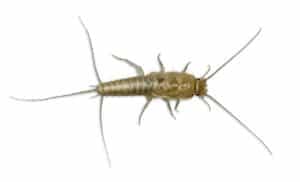Silverfish, though small and unassuming, are one of the most common household pests. These nocturnal insects can silently cause damage to your personal property, particularly targeting paper, books, wallpaper, and clothing. Their stealthy nature often leaves homeowners unaware of an infestation until it’s too late. Here is what you need to know about silverfish. What they are, how to spot them, the damage they can cause, and how a professional pest control company can help eliminate them effectively.

Silverfish, scientifically known as Lepisma saccharina, are small, wingless insects typically measuring about 12 to 19 millimeters in length. They get their name from their silvery-grey appearance and their fish-like movements, which resemble the wriggling of a fish. Silverfish are tear-shaped, with three long bristles protruding from the rear of their bodies. Their bodies are covered with shiny scales that become more visible as they age .
Here are the differentiating characteristics of silverfish:
Silverfish Appearance: Silverfish are small, wingless insects with a distinct, fish-like appearance. Their elongated, flat bodies resemble the shape of a teardrop and can range from 12 to 19 millimeters (about half an inch) in length. The body tapers towards the end, giving them a sleek, streamlined look.
Color and Texture: The name “silverfish” comes from their metallic, silvery-gray color, although some species can be bluish-gray or even brown. Their exoskeleton has a shiny, almost scaly texture, which reflects light, making them look moist or slippery.
Movement and Antennae: Silverfish are known for their quick, darting movements, which are reminiscent of how fish swim. They have two long antennae on their heads and three bristle-like appendages at the end of their bodies, further distinguishing them from other pests.
These insects are nocturnal, meaning they are most active at night and often hide during the day in dark, damp areas.
The life cycle of a silverfish begins when the female lays small, white, oval-shaped eggs. These eggs are typically hidden in cracks, crevices, or other moist areas of the home, where humidity levels are high. Depending on environmental conditions, particularly temperature and humidity, the eggs hatch within 19 to 60 days. Optimal conditions, such as warmth and moisture, speed up the hatching process. Eggs laid in less favorable environments may take longer to develop .
Upon hatching, silverfish enter the nymph stage. These immature silverfish resemble the adult form but are smaller, lack the metallic sheen, and are whitish in color. As nymphs grow, they undergo multiple molts—shedding their exoskeleton as they increase in size. Typically, nymphs molt 5 to 10 times before reaching adulthood. Each molt brings them closer to the adult form, with their silver scales becoming more prominent by the second or third molt .
Once fully mature, silverfish become adult insects, characterized by their distinctive silvery-grey color and elongated, fish-like shape. Silverfish continue to molt even in adulthood, which is rare among insects. They may molt over 50 times throughout their lives. Under favorable conditions, adult silverfish can live for up to 8 years. This long lifespan, combined with their ability to reproduce throughout their lives, makes them a persistent household pest if not properly controlled .
One of the most visible signs of a silverfish infestation is the damage they leave behind on paper-based materials. These insects have a penchant for starches and sugars, which are often found in books, wallpapers, old documents, and even cardboard boxes. You may notice irregular holes or notches along the edges of paper materials. Silverfish can also ruin clothing, especially fabrics like cotton, silk, and linen .
Silverfish droppings are another sign of an infestation. These tiny, black, pepper-like pellets can often be found in areas where silverfish are active, such as under bookshelves, in dark closets, or near stacks of paper. Though small, these droppings accumulate over time, signaling the presence of these pests .
Silverfish are nocturnal, meaning they are most active at night. If you suddenly spot one in the bathroom, kitchen, or basement during nighttime, it’s likely there are more lurking in the shadows. They tend to scuttle away quickly when exposed to light ..
Although silverfish are not known to transmit diseases or directly harm humans, they can still pose certain risks:
Silverfish shed their exoskeletons and leave behind droppings, which can accumulate in your home. These particles may act as allergens, triggering allergic reactions or worsening asthma symptoms, particularly in sensitive individuals.
Silverfish are often found in kitchens and pantries, where they may contaminate food items such as flour, cereals, and pasta. While they do not carry diseases, their presence in stored food can lead to spoilage, making the food inedible.
If a silverfish infestation persists despite home treatments, contacting professional pest control services may be necessary. Professional exterminators use advanced techniques, such as deep treatments or heat solutions, which can eradicate severe infestations. Hiring an expert ensures proper identification of the problem and targeted treatment in areas that might be missed in DIY methods. Pest control professionals also provide preventative advice to ensure silverfish don’t return
No, silverfish are not dangerous to humans. They do not bite, sting, or transmit diseases, but they can cause damage to personal belongings .
Silverfish do not typically cause structural damage to homes. However, their feeding habits can ruin paper products, textiles, and even some types of insulation .
Silverfish feed on starchy materials such as paper, glue, wallpaper, and certain fabrics. They also consume items containing cellulose and protein.
The time needed to completely eliminate a silverfish infestation depends on the severity and the size of the affected area. However, with professional treatment, infestations can typically be controlled within a few weeks .

Ready to send away pests without harming your pets? Getting started with Wise House Environmental Services is as easy as 1-2-3:
With Wise House Environmental Services, you get more than just effective pest control; you get peace of mind, knowing that your home is without pests and safer for your pets.
Our approach to pest control combines science with safety, offering you the kind of targeted, effective solutions that you won’t find with just any other pest control service. Our services have made a world of difference for homeowners, and we can do the same for you. Your pets will thank you for it!
We serve Port St. Lucie,Lake Worth, Boyton Beach, Palm Beachand the Treasure Coast.


© 2023 All Rights Reserved. | Sitemap